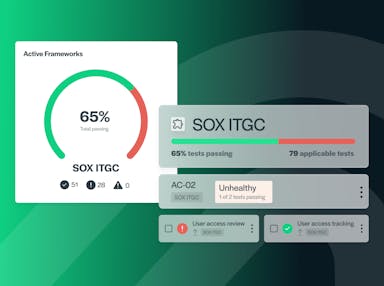
What is SOX Compliance? How To Meet Key Requirements And Avoid Penalties in 2025
Emily Bonnie
Senior Content Marketing Manager
Cavan Leung
Senior Compliance Manager
The Sarbanes-Oxley Act (SOX) is one of the most significant financial regulations in US history, designed to prevent corporate fraud and ensure transparency in financial reporting. Passed in 2002 in response to major financial scandals, SOX holds companies and executives accountable for the accuracy and integrity of their financial statements.
For many businesses, SOX compliance can feel like a complex and resource-intensive process, requiring strict internal controls, regular audits, and ongoing risk assessments. But beyond regulatory compliance, SOX offers valuable business benefits, including enhancing financial integrity, reducing fraud risk, and improving investor confidence.
In this guide, we’ll break down what SOX compliance entails, who needs to comply, internal controls and requirements, and how automation can simplify the process.
What is the Sarbanes-Oxley Act?
The Sarbanes-Oxley Act (SOX) was created in response to major corporate scandals in the late 1990s and early 2000s, after companies like Enron, WorldCom, and Tyco engaged in massive fraud. These companies manipulated their financial statements to hide debt, inflate profits, and deceive investors.
When the truth came out, billions of dollars were lost, stock prices crashed, and thousands of employees and investors lost their savings and retirement funds. The scandals exposed major weaknesses in corporate accountability, auditing practices, and financial reporting.
To prevent this from happening again, the US government passed the SOX Act in 2002, requiring publicly traded companies to be transparent and accountable about their financial reporting.
One of the key ways SOX enforces accountability is by holding executives personally responsible for their company’s financial statements. CEOs and CFOs must acknowledge that their financial reports are accurate, and if they knowingly sign off on false information, they could face serious consequences. If someone alters financial records, hides critical information, or engages in any kind of cover-up, they could face significant fines and even jail time. These strict penalties are designed to deter misconduct and ensure companies operate with integrity.
SOX also mandates strong internal controls to prevent fraud. Companies must put systems in place to safeguard financial reporting, and these controls must be tested every year to verify they are working effectively.
The SOX Act also established the Public Company Accounting Oversight Board (PCAOB) to oversee auditors and ensure they perform accurate, thorough, and unbiased audits of companies' financial statements.
The law mainly applies to public companies, but it also impacts private companies that plan to go public or work with publicly traded firms. Certain SOX provisions also apply to all organizations, including nonprofits, even though they are not subject to full compliance.

Who needs to comply with SOX?
You’re required to comply with SOX if your company falls into any of the following categories:
- Publicly traded companies: If your company is listed on the US stock exchange or files reports with the Securities and Exchange Commission (SEC), you must comply with SOX. This includes domestic and foreign companies with US listings.
- Wholly owned subsidiaries of public companies: If your company is a subsidiary of a publicly traded company, you may also need to comply with SOX, depending on how financial reporting is handled at the parent company level.
- Accounting firms that audit public companies: If you provide auditing services for publicly traded companies, SOX applies to you. The PCAOB oversees these firms to ensure they follow proper audit practices.
- Private companies preparing to go public: If your company is planning an Initial Public Offering (IPO), you’ll need to implement SOX-compliant internal controls before going public.
If your company is completely private and has no plans to go public, SOX likely doesn’t apply to you. However, some private businesses adopt SOX principles voluntarily as best practice to improve financial transparency, establish proper internal controls, and strengthen cybersecurity.
Recommended reading

Secureframe Introduces Comprehensive Support for SOX ITGC
The business benefits of SOX compliance
Complying with SOX isn’t just about avoiding penalties, it actually brings a lot of benefits to companies beyond financial reporting.
First, it strengthens financial integrity and transparency by ensuring that companies maintain accurate records. This reduces the risk of fraud and helps executives, investors, and stakeholders trust the numbers they rely on for strategic decision making.
Because of this, SOX compliance also boosts investor and market confidence. When a company follows strict financial regulations, it signals to investors that it’s accountable and reliable, which can help maintain stock value and attract more investment.
Another big advantage is more robust internal controls and risk management. Since SOX requires companies to establish strong processes for financial reporting, it helps them detect, prevent, and respond to financial and operational risks more effectively. It also improves corporate governance by holding executives personally responsible for financial statements, ensuring leadership stays engaged and accountable at every step.
While SOX wasn’t designed specifically as a cybersecurity law, its focus on financial data security and integrity has also led companies to invest more in data protection, making their systems more resilient against cyber threats. This not only protects financial information from data breaches and other security incidents, but also helps safeguard other sensitive data. And because SOX requires companies to test and document their internal control structure annually, businesses are continuously assessing and strengthening their cybersecurity posture over time.
While SOX compliance requires substantial effort upfront, it can also ultimately lead to more efficient operations. The process of implementing internal controls often forces companies to streamline financial workflows, reducing errors and inefficiencies. And on top of that, it lowers fraud risk and legal exposure by enforcing strict reporting and auditing standards. This means fewer lawsuits, regulatory fines, and reputational damage from financial misconduct.
Finally, being SOX-compliant can provide a significant competitive advantage. Companies that meet these strict regulatory requirements are seen as more trustworthy, making it easier to secure partnerships, contracts, and funding. Even though SOX compliance can be expensive and time-consuming, it ultimately helps businesses operate with greater transparency, security, and efficiency, making them stronger in the long run.

Non-compliance penalties for SOX Act violations
The Sarbanes-Oxley Act was designed to restore public trust in corporate financial reporting and prevent the kinds of fraud that have devastating ripple effects on shareholders, investors, and the economy as a whole. To ensure compliance, SOX imposes some of the strictest penalties in corporate regulation.
Civil and criminal penalties for executives
SOX holds CEOs and CFOs personally responsible for the accuracy of financial statements. If they knowingly certify false reports or fail to implement proper controls, they can face up to 20 years in prison for securities fraud (Section 807), fines up to $5 million for certifying false financial reports (Section 906), and personal liability for damages in shareholder lawsuits.
Corporate penalties
Public companies that fail to comply with SOX may face fines up to $25 million for corporate fraud. They may also be delisted from stock exchanges (NYSE, Nasdaq) if financial reports are unreliable and lose investor confidence, making it harder to raise capital.
Penalties for records tampering
SOX includes strict rules about financial document retention and prohibits destroying or altering records related to audits or investigations. Individuals can face up to 20 years in prison for destroying or falsifying documents (Section 802). Companies and auditors can be fined and banned from working with public firms if they fail to retain financial records.
Increased regulatory scrutiny
If a company fails a SOX audit, it can trigger deeper investigations by regulators like the SEC, leading to more frequent audits and monitoring, possible lawsuits from investors or shareholders, and potential takeover by regulators or forced restructuring.
Whistleblower retaliation penalties
SOX protects employees who report financial fraud. If a company retaliates against a whistleblower, the employee can sue for reinstatement, back pay, and damages and the company may face additional SEC fines and lawsuits.

SOX compliance requirements and internal controls
While SOX sets the rules and expectations for financial reporting, it doesn’t give companies prescriptive guidance on what specific internal controls they need to implement.
When it comes to selecting internal controls, most companies follow the COSO Internal Control-Integrated Framework, which was designed to help companies conduct risk assessments and organize their SOX controls. COSO’s framework covers five key areas, which work together to ensure that a company’s financial reporting is accurate and transparent.
- Control environment: The control environment sets the tone at the organizational level. If executive leadership isn’t fully committed to compliance, internal controls won’t be effective. This includes a code of ethics and clear corporate policies on financial integrity, well-defined roles and responsibilities for financial oversight, and a board and audit committee with active oversight over financial reporting.
- Risk assessment: Every company has different risks, so they need to figure out which threats could impact their financial reporting. The risk assessment involves identifying key financial risks, like errors in revenue recognition or fraudulent transactions; fraud risks, such as weak points in internal processes that could be exploited; and IT and cybersecurity risks to financial data that’s stored electronically.
- Control activities: Once a company knows its risks, it puts different types of internal controls in place to prevent or detect fraud and errors. These include:
-Financial controls, like requiring approval for large transactions and conducting monthly reconciliations.
-IT General Controls (ITGCs), such as restricting user access to financial systems and requiring strong passwords.
-Segregation of duties, which ensure that no single person has too much control over a financial process. For example, the person who approves payments shouldn’t be the same person who processes them. - Information and communication: Companies need a way to ensure financial data is properly recorded, shared, and reported. This includes documenting financial policies and procedures, establishing secure and clear reporting channels for financial data, and implementing whistleblower mechanisms for reporting fraud.
- Monitoring activities: Once a company sets up the proper internal controls, it needs to continuously monitor and improve them so they remain effective over time. Examples include periodic internal and external audits to verify compliance, regular control testing to find weaknesses or misconfigurations, and continuously monitoring IT systems to detect cybersecurity risks.
Recommended reading

15 Essential Regulatory and Security Compliance Frameworks
How to select SOX internal controls for your organization
If SOX doesn’t prescribe specific internal controls, how do you know which ones to implement? The key is to tailor your controls to your organization’s unique risks and financial processes.
Let’s walk through the process of identifying, selecting, and implementing the right internal controls based on your organization’s specific needs and risk profile.
Step 1. Conduct a risk assessment
While COSO doesn’t specify a strict, step-by-step risk assessment methodology, it does outline four key principles for conducting effective risk assessments. Most organizations structure their risk assessment process around these principles.
The first step is to define objectives and scope, determining key financial reporting and compliance goals while identifying which systems, departments, or processes should be included in the assessment.
Once objectives are established, organizations need to identify and analyze risks that could prevent them from meeting these goals. This involves assessing vulnerabilities in financial reporting and processes, IT security, and operational workflows. What threats are associated with human error, fraud, IT security breaches, third-party relationships, and regulatory changes?
After identifying risks, organizations prioritize them based on likelihood and impact. High-risk areas, such as financial misstatements or unauthorized system access, require stronger controls.
Step 2. Map risks to SOX internal controls
Once risks are identified and assessed, businesses must map risks to existing controls and evaluate whether their current controls are strong enough to prevent financial misstatements or unauthorized changes.
If not, implement new control activities to mitigate these risks. This can involve segregation of duties, new approval workflows, or adding automated monitoring systems. IT security measures, such as access restrictions, audit logging, and encryption, should also be aligned with SOX compliance requirements.
Controls are typically divided into two categories: preventive controls and detective controls. Preventive controls are designed to stop fraud and errors before they happen (such as requiring management approval for large transactions). Detective controls help identify issues after they occur (such as audit logs, reconciliations, and financial statement reviews).
Step 3. Establish a confidential whistleblower system
Section 301 of SOX requires companies to establish a confidential whistleblower system, allowing employees to report financial fraud anonymously and without fear of retaliation. It’s important to provide multiple reporting channels, typically through:
- Anonymous hotline: A toll-free phone number, ideally managed by an independent third party, that allows employees to report issues without revealing their identity.
- Online reporting portal: An online form where employees can submit concerns securely and anonymously.
- Physical drop boxes: A secure box in a private location where employees can submit written concerns without being seen.
- Direct reporting to an audit committee or ombudsman: Employees should have a direct line to an independent committee in case they prefer in-person communication.
- Third-party whistleblower services: Neutral third-party services follow SOX requirements and ensure true anonymity.
It’s essential that whichever whistleblower system you choose does not track or monitor IP addresses, allows anonymous submissions, and uses secure communication channels. Restrict access of reported complaints to authorized personnel such as legal, compliance, or an audit committee.
Step 4. Undergo an independent SOX compliance audit
Public companies must schedule annual SOX audits as part of their financial reporting requirements. Management must conduct an internal audit each year, and external auditors must also perform an independent assessment of those controls.
Companies typically work with an independent external auditing firm or accounting firm to complete the audit process before filing their annual reports with the SEC.
External auditors review the company’s internal control framework, along with financial statements, reporting systems, and past audit findings to assess whether there are recurring issues or areas of concern. They also examine IT systems that impact financial reporting, such as ERP and accounting software, to ensure that financial data is accurately processed and protected from unauthorized changes.
Once the initial review is complete, auditors evaluate whether the company has documented and implemented effective internal controls. This includes assessing the control environment, which determines whether management enforces ethical financial practices.
They also review segregation of duties, ensuring that no single employee has unchecked control over financial transactions. Auditors examine approval workflows to confirm that financial transactions are properly reviewed before execution and assess access controls to determine who has permission to modify financial data.
Auditors will also test how well implemented controls function in practice. This may involve sample transaction testing, where specific financial transactions are reviewed to ensure they followed the correct procedures.
Auditors also perform IT controls testing, which includes checking system access logs, password policies, and change management processes. They conduct audit trail reviews to verify that financial data hasn’t been tampered with and may interview employees or conduct walkthroughs to confirm that control procedures are actually being followed as documented.
If auditors find gaps or weaknesses in the company’s internal controls, they classify them into three categories:
- Material weaknesses: Serious issues that could result in inaccurate financial statements and require immediate correction.
- Significant deficiencies: Less severe, but still important weaknesses that need improvement.
- Control deficiencies: Minor issues that don’t pose an immediate risk but should still be addressed.
When deficiencies are identified, the company must implement corrective actions to strengthen internal controls. After making necessary adjustments, controls must be retested to ensure they are functioning as intended. Finally, executives, including the CEO and CFO, must certify compliance and formally attest that the company’s financial controls are effective.
The findings from the audit are compiled into a SOX audit report, which is presented to management, the board, and regulatory bodies if necessary. In cases of suspected non-compliance, the SEC or PCAOB may conduct additional audits or investigations, but these usually happen in response to a specific complaint, whistleblower report, or signs of financial misconduct.

Step 5. Continuous monitoring and improvement
Finally, companies must monitor and update their risk assessments and control activities regularly. Since risks are always evolving, companies must identify and respond to significant changes by updating their risk assessments when business conditions, regulations, or potential threats shift.
All findings and updates should be properly documented and reported to management and the audit committee to ensure continuous compliance and improvement.
Using automation to streamline SOX compliance
Implementing SOX compliance requirements can be a complex and time-consuming process, requiring organizations to establish rigorous financial controls, ensure IT system integrity, and continuously monitor compliance. Automation tools like Secureframe make these tasks significantly easier, especially regarding SOX IT General Controls (ITGCs).
SOX ITGCs ensure that IT systems related to financial reporting are accurate, secure, and reliable, safeguarding the integrity of financial information. Secureframe streamlines SOX ITGC compliance by automating evidence collection, policy management, risk assessments, and continuous monitoring, significantly reducing manual effort and helping organizations stay audit-ready.
- Automated evidence collection: With hundreds of deep integrations, Secureframe automatically collects and maps audit-ready evidence against SOX ITGC requirements, eliminating manual work.
- Customizable policy library: Access policy and process templates developed by compliance experts and former auditors, or customize policies to align with your organization’s objectives.
- Continuous monitoring: Secureframe integrates with your tech stack to monitor for failing controls, misconfigurations, and compliance gaps, ensuring ongoing compliance and minimizing risks.
- Tailored remediation guidance: AI-powered workflows identify and resolve vulnerabilities and compliance gaps quickly with customized recommendations for control remediation.
- Third-party risk management: Use AI-powered risk assessments and automated monitoring to identify, assess, and mitigate vendor risks that could impact your SOX ITGC compliance.
- Access management: Simplify user access reviews and vendor access monitoring to prevent unauthorized access.
- Centralized compliance management: View and manage SOX ITGC controls in a single, unified dashboard, with the ability to assign control owners and track remediation progress.
See why 95% of Secureframe users say our platform helps them achieve compliance faster and more efficiently by scheduling a demo with a product expert.
Use trust to accelerate growth
FAQs
What is the SOX Act?
The Sarbanes-Oxley Act of 2002 (SOX) is a U.S. federal law designed to prevent corporate fraud and ensure financial transparency in publicly traded companies. It establishes strict internal controls, financial reporting requirements, and penalties for misconduct to protect investors and maintain trust in the financial system.
What are the key requirements of SOX compliance?
SOX regulations require public companies to implement and maintain strong internal controls over financial reporting. This includes CEO and CFO certification of financial statements (Section 302), annual assessment of internal controls (Section 404), whistleblower protections (Section 806), and strict penalties for fraudulent activities and document tampering (Sections 802 & 906).
Is SOX a legal requirement?
Yes, SOX is a legal requirement for all publicly traded companies in the U.S. and their subsidiaries. It is enforced by the SEC (Securities and Exchange Commission) and the PCAOB (Public Company Accounting Oversight Board).
What is an example of a SOX violation?
A common SOX violation is fraudulent financial reporting, such as intentionally inflating revenue to mislead investors. Other violations include failure to maintain proper internal controls, destroying or falsifying financial records, retaliating against whistleblowers, and CEOs or CFOs certifying false financial statements.

Emily Bonnie
Senior Content Marketing Manager
Emily Bonnie is a seasoned digital marketing strategist with over ten years of experience creating content that attracts, engages, and converts for leading SaaS companies. At Secureframe, she helps demystify complex governance, risk, and compliance (GRC) topics, turning technical frameworks and regulations into accessible, actionable guidance. Her work aims to empower organizations of all sizes to strengthen their security posture, streamline compliance, and build lasting trust with customers.

Cavan Leung
Senior Compliance Manager
Cavan Leung, CSSK, CISA, CISSP is an information security leader with over a decade of experience in the security, privacy, and compliance industries. A former auditor and security consultant, Cavan performed ERP and SOX compliance audits at Deloitte, as well as SOC 1, SOC 2, GDPR, and ISO 27001 compliance assessments for Fortune 500 companies at Schellman. At Secureframe, he’s helped hundreds of customers achieve compliance with SOC 2, ISO 27001, GDPR, HIPAA, and more.